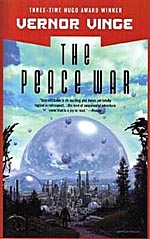
![]() couchtomoon
couchtomoon
7/22/2015
![]()
In 1997, the ultimate weapon is conceived: The Bobbler. A vague business bureaucracy that calls itself the Peace Authority uses the Bobbler to end warfare by--don't laugh-- forming giant, impenetrable, reflective bubbles (bobbles) to trap enemies inside. These bobbles--seriously, stop laughing, it wasn't that bad--can be as large as buildings and mountains, and become permanent geographical features on the landscape. We encounter our main characters in year 2048, fifty years after this event, when a decayed, rundown society is controlled by the Peace Authority and/or feudalistic lords, and medicine is prohibited and basic daily supplies are limited. But a bobble explodes, and a small boy with super intelligence may be the key to aid the rebellious Tinkers in confronting the evil Peace Authority.
Not quite the big government paranoia alert you might be expecting,but, for those of us who grew up admiring the Federation, it might rankle a bit with its anti-New World Order vibe. In this case, however, the Peace Authority is actually born out of a corporate science monopoly gone wild, and that's where a poorly regulated business sector will get us, won't it. More eyebrow-raising is the dubiousness of an entire society making limited, unsupported assumptions about the bobbles, which prove to be completely wrong, while alternative theories will appear obvious, and more probable, to the reader early into the novel.
Then there is the special little black boy protagonist who befriends the old white man protagonist. "This was a gentle racism" the book says when the cops suggest that the orphan boy move in with a local family of color (22). If that's gentle racism, what kind of racism is the naïve '80s effort to spotlight nonwhite characters, because, in this case, the situation serves to demonstrate the goodness of the old white man for adopting the little boy (so now we know this is a special, goodhearted white man), and it amplifies the boy's giftedness (he came off the streets, he's black, he speaks Spanish, therefore we know his giftedness is rare and pure). But, fortunately, not everybody else is white: the ambivalent, sell-out cop is Mexican-American, and the evil, ladder-climbing Peace Authority underling (who sleeps with the Mexican cop) is Asian-American. So yay '80s.With many genre novels, it's easy to picture the Hollywood movie the writers have in their heads when they write these things. The Peace War is no different, but it works better here than most other novels. The camera pans over scene, cue music, zoom in on cop eyeballing little boy, soundtrack tinkles, zoom in on boy playing video game, music crescendos, boy runs... it's simple, it's visual, but this habit leeches dimension out of novels. I'm not sure if this a skill they teach in writers' workshops, or just a result of too much exposure to Hollywood, (more likely a desire to sell to Hollywood), but novels aren't supposed to be like movies. If I wanted a movie, I would save 8-20 hours of my life and just watch a movie.
But script style and gentle racism aside, the plot keeps trucking and I didn't mind following along. Little Wili is compelling, and he's interesting enough to hook readers into the sequel. The bungled up bobbles are ridiculous, yet they impact the plot in an interesting way that also might hook readers into the sequel. I admit to being slightly tempted to find out what happens to grown up Wili in the sequel, but it's nothing a quick wiki search can't cure. It's not boring, it's not terrible, but I managed to escape the ever-dreaded sequel grab.
http://couchtomoon.wordpress.com